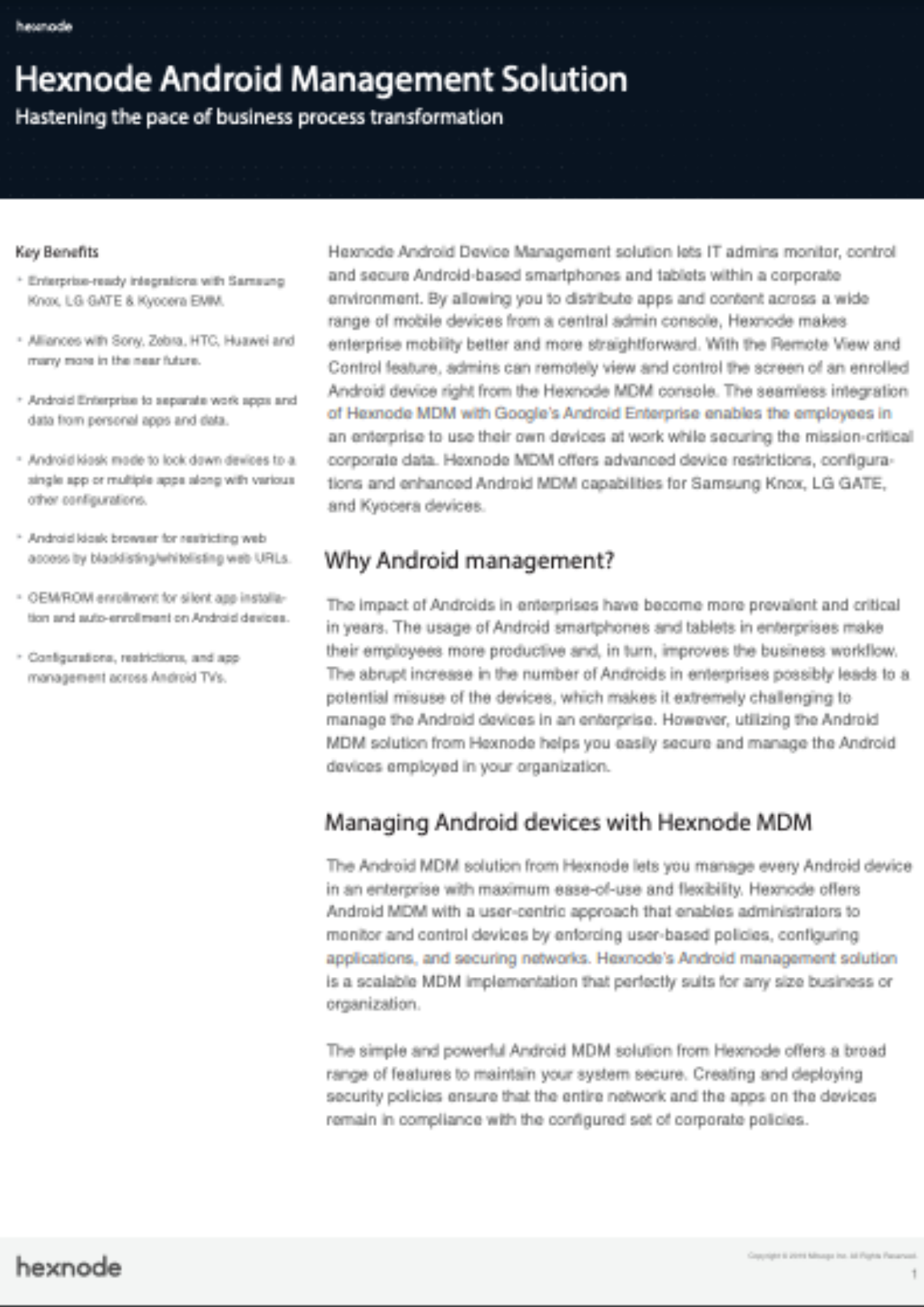The big ‘HOWs’ of managing custom Android OS (custom ROM) in the workplace
Custom Android OS is a personalized Android firmware designed based on the Android open-source code provided by Google.

Get fresh insights, pro tips, and thought starters–only the best of posts for you.
Lizzie Warren
Feb 17, 2023
12 min read

Lost in the labyrinth of managing non-GMS devices? 🤯😥
Fear not, as we’ve got a solution that’ll steer you in the right direction! 🧭
Managing Android devices can be a challenging task in itself, but it can be even more daunting when you have to manage non-GMS (Google Mobile Services) devices. They may not have access to the suite of Google apps and services that most Android devices come with, making it difficult to manage them efficiently. In a world where we are very convenient with using Google’s ecosystem, what happens when these devices don’t come with the support of Google Mobile Services? 😱
Confused? Don’t let this puzzle leave you scratching your head. With this blog, let’s uncover the secrets to seamlessly provision and manage non-GMS devices. Also, on the go let’s look at some interesting facts about them! 😉
Let’s get started! 💪
Before starting our journey to simplify the art of managing non-GMS devices, it is important to note the two distinct categories of Android based smart devices, each with varying levels of functionality and compatibility. This information may be uncharted territory for those who haven’t explored these terms before. No worries let’s make it simple!
The term “GMS” refers to “Google Mobile Services,” which is a collection of exclusive software and APIs. These services include Gmail, Google Maps, Google Play Store, and others. On Android-powered devices such as smartphones, tablets, and smart TVs, these Google Services are often pre-installed at the system level and have the ability to run Google’s apps and services.
The Android Open-Source Project (AOSP) operating system without the GMS Package is known as a non-GMS based Android OS. Since an OS without GMS is a lightweight alternative, fewer resources are used, including storage, RAM and background processing. Devices running this type of OS, such as the Amazon Fire Tablet or Xiaomi Mi Box, even use less battery power compared to those with GMS.
Are you torn between choosing a GMS or non-GMS Android device? 😕 This decision can be crucial for the development and management of your enterprise! So, let’s light up and check which device suits the best.
GMS Android devices are the go-to option for most users who seek convenience and integration with Google services. For the enterprise sector, non-GMS devices offer more freedom and flexibility for provisioning, deployment, and customization to meet specific requirements. The enterprises can exercise greater control over their devices by using APIs from multiple services, rather than solely relying on GMS services. This allows for more precise management of update schedules, stability, and other critical factors.
Ultimately, the decision between GMS and non-GMS devices depends on several factors, that includes:
Remember, when it comes to choosing the best Android device for your needs, it’s important to consider all the factors that are most important to you and your enterprise, including privacy and security. With the right device in hand, you’ll be well on your way to a successful and productive future!
If you’re opting for non-GMS devices for your enterprise, then there can be many obstacles in your way. Even though this might seem like a challenge, it’s not something that hasn’t been tackled before. To ensure effective management, it’s important to understand these challenges beforehand. So, let’s have a look at them!
Despite these challenges, managing non-GMS devices can be a rewarding experience for those who are willing to put in the effort. By understanding the device’s limitations and taking the necessary steps to overcome them, you can unlock the full potential of non-GMS devices and make the most of your investment. So, are you ready to take on the challenge?
Get started with Hexnode’s Android Management solution to improve efficiency, increase productivity, save time and overhead costs of managing your corporate devices.

Featured resource
Hexnode Android Management Solution
Keeping all these challenges in mind, are you struggling to find a solution for them? Then Hexnode UEM can help you out!
Devices can be enrolled using a variety of techniques, but some popular techniques are not supported by non-GMS AOSP (Android Open-Source Project) devices. For example, enrollment process cannot be done through methods such as the 6-tap QR code, Android Enterprise or Zero Touch Enrollment.
The usual manual enrollment of Android devices to Hexnode UEM involves two steps. They are the installation of the Hexnode app on the device, followed by the enrollment process where the user fills in the necessary information in the app. However, there may be instances where a device doesn’t support a specific enrollment method. For example, if the Google Play Store is disabled on the device, downloading the Hexnode app becomes impossible. Another scenario is when the device lacks a camera or it is disabled, which is common in hazardous areas, military facilities, or sensitive workplaces. This makes it impossible to use the QR code enrollment method as it requires access to the camera.
For all these scenarios, Hexnode UEM offers an answer for you and your organization! The IT admin can use the following method supported by Hexnode UEM for the smooth onboarding of non-GMS devices:
With this approach, Android devices running version 5.0 or later, as well as devices using AOSP or other Android-based operating systems, can be enrolled in Hexnode UEM. For this enrollment process, follow the steps below:
Apart from this IT admins can also use the Enrollment using Hexnode for Work app method. We can utilize this method in two ways for non-GMS devices. It includes:
Case 1: Enrollment of device without Google Play Store but has Camera
Case 2: Enrollment of devices without Camera or Play Store Service
With Hexnode UEM, organizations can ensure that their non-GMS devices are secure, compliant, and used effectively. Here are some of the key features of Hexnode UEM that make it a top choice for non-GMS device management:
Hexnode UEM allows administrators to remotely manage and secure non-GMS devices, including smartphones, tablets, and laptops, from a centralized console.
IT admins can manage and distribute apps to non-GMS devices, including both in-house and public apps, and enforce app policies to enhance device security. Using Hexnode UEM, they have the ability to remotely manage applications. This include installing and uninstalling, marking apps as mandatory, deploying app catalogs, and more.
With Hexnode UEM, corporations can manage their data efficiently with its powerful file management feature. It provides a simple and secure solution for managing data, while improving workplace efficiency and allowing employees to access corporate content easily.
IT admins can effortlessly set up Wi-Fi connectivity on non-GMS devices using Hexnode UEM. Users can connect to the enterprise Wi-Fi without having to manually enter the password. This ensures a more secure network and eliminating the need for them to have access to sensitive login information.
Hexnode UEM’s kiosk management feature provides a comprehensive solution for organizations to secure and manage their public-facing devices, ensuring that the users only have access to the content and functions that are intended for them.
Hexnode UEM provides robust security features such as device encryption, device lockdown, and password policies to keep non-GMS devices secure.
The solution allows organizations to enforce compliance policies, such as device restrictions and security requirements, to ensure that non-GMS devices are secure and compliant with organizational, and government specified standards.
Using Hexnode UEM, IT admins have the power to monitor and control the data consumption of enrolled devices, making it ideal for enterprises. This feature allows administrators to set data usage limits for individual apps or for the device. If the limit exceeds, the admin will receive notifications, providing valuable insight into the data usage habits of their users.
Hexnode UEM provides detailed reporting and analytical capabilities that help organizations understand device usage patterns and identify areas for improvement.
The solution integrates with popular enterprise tools, such as Microsoft Active Directory, to provide a seamless experience for administrators and users.
In conclusion, the availability of GMS on an Android device can often be a deciding factor in one’s choice of device. The two main situations that could prevent devices from having access to GMS are when the devices do not come with GMS (like the Amazon Kindle) or when they join a closed network. So, whether you’re an individual or an enterprise, it’s important to weigh the pros and cons and choose the best Android device that fits your needs.
Hexnode UEM provides a comprehensive solution for organizations looking to manage their non-GMS devices effectively. It also offers seamless device management by supporting various enrollment methods and tackling non-GMS device challenges. So, get ready to take control of the technology for your enterprise with Hexnode UEM and launch it into action!
Give Hexnode a go! Try out the 14 day free trial of Hexnode UEM and securely manage your devices.
SIGN UP NOW